Re Ian Bremmer 'Could third-party candidates upend the 2024 US election?' 3 April The current political movement in the USA…
The UN Decade on Biodiversity 2011-2018
Written by Diana Thebaud Nicholson // November 20, 2018 // Biodiversity, Science & Technology, United Nations // 1 Comment

CBD Strategic Plan for UN Decade of Biodiversity
Background Information
Beaty Biodiversity Museum (UBC)
20 November
The world needs a Paris-style accord for biodiversity
Countries meet in Egypt to lay foundations for a new global treaty to tackle worrying species loss.
(Eco Business) This week representatives from more than 190 countries will gather in Egypt to decide how to better protect biodiversity, currently facing grave threats from human activity.
“There is much less progress than expected,” said Obdulio Menghi, a biologist and president of the Biodiversity Foundation in Argentina. “The CBD is an empty shell and I do not have much hope for this new summit. The solution lies in the world of economics and with the politicians of every government.”
Worldwide, populations of vertebrate animals such as mammals, birds, fish, amphibians and reptiles have diminished by 60 per cent between 1970 and 2014, according to the recently published Live Planet report by the World Wildlife Fund (WWF).
Deemed equally as important as the Paris Climate Change Agreement, the Aichi biodiversity targets were created in 2010. There are 20 ambitious objectives to conserve biodiversity that range from preventing the extinction of species to reducing the rate of deforestation.
Each of the 194 countries that signed up must comply with the goals before 2020, when a new agreement must be adopted. With less than two years to go, only 5 per cent of countries are on track to meet the targets, according to a 2016 report by a group of international environmental organisations.
Despite the fact that three-quarters of signatories are making progress, none is moving fast enough to meet the 2020 target. Worse, 20 per cent of the countries have not made any progress or have actually weakened protections for biodiversity
8 November
Compositional response of Amazon forests to climate change
(Global Change Biology) Tropical forests represent the world’s most biodiverse ecosystems, as well as providing its largest stores of living carbon and contributing more to biomass productivity than any other biome on the planet. Changes here can therefore have global consequences, potentially nowhere more so than in Amazonia where between 6,000 and 16,000 tree species exist (Cardoso et al., 2017; Ter Steege et al., 2013) and as much as 100 Pg of carbon is stored in biomass (Feldpausch et al., 2012). While the physical, chemical, and biological environment have all been changing over recent decades, it is the changes in climate—both documented and projected—which are widely expected to cause some of the most profound changes in forest communities and ecosystem processes (Esquivel‐Muelbert, Baker, et al., 2017; Thomas et al., 2004). For example, higher temperatures and intensifying drought may threaten larger trees due to hydraulic failure (McDowell & Allen, 2015; Rowland et al., 2015), which could eventually compromise forest biomass and productivity. In Amazonia, because forest diversity is concentrated in the wetter, least seasonal forests (Francis & Currie, 2003; Gentry, 1988), a persistent lengthening of the dry season might threaten a large portion of tropical biodiversity. Here we aim to better understand how Amazonian trees have responded to the last 30 years of environmental change, by analysing floristic records from long‐term tree monitoring in the Neotropics to assess the potential compositional changes to date.
6 November
Stop biodiversity loss or we could face our own extinction, warns UN
(The Guardian) Pașca Palmer is executive secretary of the UN Convention on Biological Diversity – the world body responsible for maintaining the natural life support systems on which humanity depends.
Its members – 195 states and the EU – will meet in Sharm el Sheikh, Egypt, this month to start discussions on a new framework for managing the world’s ecosystems and wildlife. This will kick off two years of frenetic negotiations, which Pașca Palmer hopes will culminate in an ambitious new global deal at the next conference in Beijing in 2020.
Conservationists are desperate for a biodiversity accord that will carry the same weight as the Paris climate agreement. But so far, this subject has received miserably little attention even though many scientists say it poses at least an equal threat to humanity.
The last two major biodiversity agreements – in 2002 and 2010 – have failed to stem the worst loss of life on Earth since the demise of the dinosaurs.
Eight years ago, under the Aichi Biodiversity Targets, nations promised to at least halve the loss of natural habitats, ensure sustainable fishing in all waters, and expand nature reserves from 10% to 17% of the world’s land by 2020. But many nations have fallen behind, and those that have created more protected areas have done little to police them. “Paper reserves” can now be found from Brazil to China.
The issue is also low on the political agenda. Compared to climate summits, few heads of state attend biodiversity talks. Even before Donald Trump, the US refused to ratify the treaty and only sends an observer. Along with the Vatican, it is the only UN state not to participate.
One cause for hope was a convergence of scientific concerns and growing interest from the business community. Last month, the UN’s top climate and biodiversity institutions and scientists held their first joint meeting. They found that nature-based solutions – such as forest protection, tree planting, land restoration and soil management – could provide up to a third of the carbon absorption needed to keep global warming within the Paris agreement parameters. In future the two UN arms of climate and biodiversity should issue joint assessments. She also noted that although politics in some countries were moving in the wrong direction, there were also positive developments such as French president, Emmanuel Macron, recently being the first world leader to note that the climate issue cannot be solved without a halt in biodiversity loss. This will be on the agenda of the next G7 summit in France.
31 October
Wait, Have We Really Wiped Out 60 Percent of Animals?
Many of the blaring headlines about a major new World Wildlife Fund report are mischaracterizing how many species humans have been responsible for wiping out. The reality is not exactly that “humanity has wiped out 60 percent of animals since 1970,” though the real news is still grim, writes Ed Yong.
(The Atlantic) Since Monday, news networks and social media has been abuzz with the claim that, as the Guardian among others tweeted, “humanity has wiped out 60 percent of animals since 1970”—a stark and staggering figure based on the latest iteration of the WWF’s Living Planet report.
The team behind the Living Planet Index relied on previous studies in which researchers estimated the size of different animal populations, whether through direct counts, camera traps, satellites, or proxies like the presence of nests or tracks. The team collated such estimates for 16,700 populations of mammals, birds, reptiles, amphibians, and fish, across 4,000 species. (”Populations” here refers to pockets of individuals from a given species that live in distinct geographical areas.) …
Ultimately, they found that between 1970 and 2014, the size of vertebrate populations has declined by 60 percent on average. That is absolutely not the same as saying that humans have culled 60 percent of animals—a distinction that the report’s technical supplement explicitly states. “It is not a census of all wildlife but reports how wildlife populations have changed in size,” the authors write.
30 October
Humanity has wiped out 60% of animal populations since 1970, report finds
The huge loss is a tragedy in itself but also threatens the survival of civilisation, say the world’s leading scientists
(The Guardian) Humanity has wiped out 60% of mammals, birds, fish and reptiles since 1970, leading the world’s foremost experts to warn that the annihilation of wildlife is now an emergency that threatens civilisation.
The new estimate of the massacre of wildlife is made in a major report produced by WWF and involving 59 scientists from across the globe. It finds that the vast and growing consumption of food and resources by the global population is destroying the web of life, billions of years in the making, upon which human society ultimately depends for clean air, water and everything else.
The biggest cause of wildlife losses is the destruction of natural habitats, much of it to create farmland. Three-quarters of all land on Earth is now significantly affected by human activities. Killing for food is the next biggest cause – 300 mammal species are being eaten into extinction – while the oceans are massively overfished, with more than half now being industrially fished.
Chemical pollution is also significant: half the world’s killer whale populations are now doomed to die from PCB contamination. Global trade introduces invasive species and disease, with amphibians decimated by a fungal disease thought to be spread by the pet trade.
21 May
Humans just 0.01% of all life but have destroyed 83% of wild mammals – study
(The Guardian) Groundbreaking assessment of all life on Earth reveals humanity’s surprisingly tiny part in it as well as our disproportionate impact
Humankind is revealed as simultaneously insignificant and utterly dominant in the grand scheme of life on Earth by a groundbreaking new assessment of all life on the planet.
The world’s 7.6 billion people represent just 0.01% of all living things, according to the study. Yet since the dawn of civilisation, humanity has caused the loss of 83% of all wild mammals and half of plants, while livestock kept by humans abounds
18 May
Saving Africa’s wildlife
A 21st-century Noah’s ark transports animals back to places where they’ve been wiped out.
(WaPost) Two decades ago, this patch of Malawian forest was almost emptied of wildlife. The last elephants had been poached. The lions had been caught in snare traps. Other species died off as their range was diced by machete-wielding farmers.
Now the animals have returned in a modern-day Noah’s ark — a bold attempt by private philanthropists and environmentalists to move wildlife from other parts of the continent. … part of an experiment in turning back the clock to a time of greater biodiversity.
African Parks, the nonprofit organization that arranges the shipments of the animals, aims to restore populations that once existed in some of the world’s most remote places. …
Translocation is also enormously expensive, and securing the parks requires its own massive investment — the group now has the largest counter-poaching force of any private organization on the continent, around 1,000 rangers. But it has a substantial pipeline to the world’s wealthiest donors. Last year, Britain’s Prince Harry was named its president. In 2016, the group raised nearly $25 million, mostly from European benefactors.
10 May
Maasai herders driven off land to make way for luxury safaris, report says
Tanzanian government accused of putting indigenous people at risk in order to grant foreign tourists access to Serengeti wildlife
(Th Guardian) Hundreds of homes have been burned and tens of thousands of people driven from ancestral land in Loliondo in the Ngorongoro district in recent years to benefit high-end tourists and a Middle Eastern royal family, says the report by the California-based thinktank the Oakland Institute.
Although carried out in the name of conservation, these measures enable wealthy foreigners to watch or hunt lions, zebra, wildebeest, giraffes and other wildlife, while the authorities exclude local people and their cattle from watering holes and arable land, the institute says.
The report, released on Thursday highlights the famine and fear caused by biodiversity loss, climate change, inequality and discrimination towards indigenous groups.
21 April
All people, not just experts, must ensure the conservation of Earth’s vast biodiversity
James Schaefer, professor of biology at Trent University and author of Two Houses of Oikos – Essays from the Environmental Age
(Globe & Mail) Ours is a long and remarkable story. As humans came to dominate the earth, we appointed ourselves – by intent or by accident – as its curator. Now, the fate of myriad species must be settled. To succeed in this task, we need to focus on one species in particular: people.
Conservation is too important to be the exclusive preserve of conservation biologists. It must attract policy makers, practitioners and the public. It must advance scientific understanding and Indigenous knowledge. It must foster incentives for citizens
26 March
Jonathan Gatehouse: Human activity pushing Earth towards ‘sixth mass species extinction,’ report warns
(CBC The National) The Earth is rapidly losing its capacity to support human life, warns a new report.
Human activity is degrading the landscape, driving species to extinction and worsening the effects of climate change, it says.
Two-fifths of humanity — some 3.2 billion people — are already in danger, warns the study from the Intergovernmental Science-Policy Platform on Biodiversity and Ecosystem Services (IPBES), released at a conference in Colombia this morning.
The peer-reviewed assessment, produced over three years by 100 experts from 45 countries, says that land loss and drought will displace at least 50 million people by 2050, and as many as 700 million over the coming four decades.
Less than a quarter of the planet remains untouched by human activity, but at current rates of expansion and exploitation, that figure will fall to less than 10 per cent by 2050.
22 March
Great Pacific Garbage Patch weighs more than 43,000 cars and is much larger than we thought
(PBS Newshour) the overwhelming bulk of the Great Pacific Garbage Patch is large pieces of trash. Most are hard plastics — think tupperwares, bottles, lids, buckets, ropes and lots of fishing nets. Fishing nets made up nearly half the plastic discovered.
The large and medium-sized plastics bigger than 2 inches, known as megaplastics and macroplastics, comprised more than 75 percent of the total mass of the Great Pacific Garbage Patch.
Based on inscriptions, most of the plastic collected in the study originated in Asia — namely China and Japan — but that makes sense given the North Pacific Current runs west to east. The oldest piece of plastic they found dated to 1977.
21 March
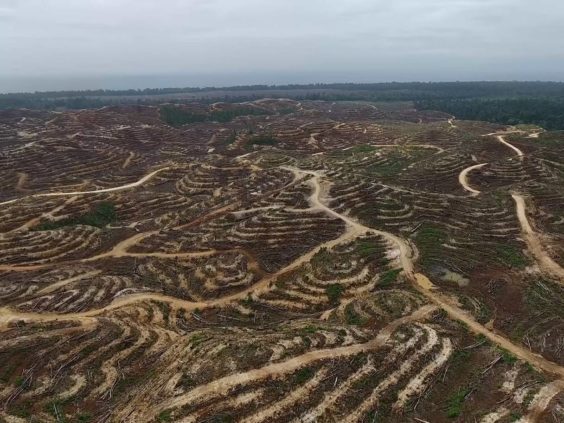 Drone footage reveals the extent of forest destruction in Papua New Guinea
Drone footage reveals the extent of forest destruction in Papua New Guinea
Alessio Bariviera/Global Witness
Alarming photos reveal devastating scale of rainforest destruction in Papua New Guinea
(The Independent) Exclusive: Impact of forest loss on communities and ecosystems revealed in series of images and footage collected by environmental campaigners Global Witness following report on illegal logging in the South Pacific nation
Photos and footage documenting the devastating impact illegal logging on the people and ecosystems of Papua New Guinea, have been released by environmental campaigners.
One of the most biologically diverse countries in the world, the rainforests that cover much of the country and provide a home for many of its unique species are vanishing fast.
By 2014, nearly one third of the country’s commercially viable forests had been logged and demand from the global timber trade is driving further deforestation and leading to abuses of indigenous communities’ rights.
20 March
Bigger Is Not Better for Ocean Conservation
By Luiz A. Rocha, associate curator of fishes and a co-leader of the Hope for Reefs initiative, California Academy of Sciences.
(NYT) From Hawaii to Brazil to Britain, the establishment of large marine protected areas, thousands of square miles in size, is on the rise. These areas are set aside by governments to protect fisheries and ecosystems; human activities within them generally are managed or restricted. While these vast expanses of open ocean are important, their protection should not come before coastal waters are secured. But in some cases, that’s what is happening.
Near-shore waters have a greater diversity of species and face more immediate threats from energy extraction, tourism, development, habitat degradation and overfishing. If we leave these places at risk, we’re not really accomplishing the goal of protecting the seas.
We need more science-based conservation, not convenient conservation. Countries should focus on areas where fish spawn and feed amid threats from energy development, tourism, development, habitat destruction and fishing.
Second, we need carefully written rules setting sustainable catch limits and requiring commercial fishing gear that avoids catching unwanted fish and other marine creatures. Setting aside protected areas that amount to nothing but a rounding error in the range size of tunas won’t protect them from overfishing.
This “just add water” approach to marine protection is a flawed recipe for conservation that is failing to protect the areas of our oceans that require our immediate attention.
2017
 Scientists Discover Real-Life Kermit The Frog In Costa Rica
Scientists Discover Real-Life Kermit The Frog In Costa Rica
(Bored Panda) Kermit the Frog’s distant live-action cousin has just been discovered in the jungles of Costa Rica. The new species, Diane’s Bare-hearted Glassfrog (Hyalinobatrachium dianae), is most remarkable for its translucent underbelly (hence the name “glassfrog”) and its bulging white eyes, which look just like Kermit’s!
The frog evaded discovery as long as it did because of its remote location in the tropical Caribbean foothills of Costa Rica and because its mating call sounds just like an insect’s call – the scientists who discovered the frog described its call as “a single tonal long metallic whistle-like note.” (March 2016)
14 June
23 new sites added to UNESCO’s World Network of Biosphere Reserves
(UNESCO) The International Coordinating Council of the Man and the Biosphere (MAB) Programme meeting in Paris has added 23 new sites to the World Network of Biosphere, including four that straddle national boundaries. These additions were made during the MAB Council’s meeting in Paris from 12 to 15 June.
The Council also approved extensions to 11 reserves and the renaming of another, as well as the request by Bulgaria and the United States of America to withdraw some of their reserves from the World Network.
The Bulgarian sites that have been withdrawn are: Doupkata; Kamtchia; Koupena.
Sites that have been withdrawn by the US sites are: Aleutian Islands; Beaver Creek; California Coast Ranges; Carolinian South Atlantic; Central Plains; Coram; Desert; Fraser; H.J. Andrews; Hubbard Brook; Konza Prairie Research Natural Area; Land Between the Lake; Niwot Ridge; Noatak; Stanislas-Tuolumne; Three Sisters; Virgin Islands.
Biosphere Reserves are learning places for sustainable development whose aim is to reconcile biodiversity conservation and the sustainable use of natural resources. New sites are designated every year by the MAB Council which is composed of representatives of 34 elected UNESCO Member.
24 May
Conservationists Could Be Saving More Biodiversity in Less Space
In a paper published in this week’s issue of Nature, three researchers argue that the protection of outlier species … could have disproportionate—and, to a large extent, untapped—benefits for global biodiversity.
(The New Yorker) Biodiversity is usually understood in simple numerical terms: more species means more biodiversity. In the United States and abroad, most conservation laws are designed to protect as many species as funding and politics allow. But just as diversity within a human population can be measured by more than skin color, diversity within animal and plant communities can be measured in a number of ways. Some species have a unique evolutionary lineage; others perform unusual or even irreplaceable functions in their ecosystems; and still others, such as the solenodons, are sui generis by almost any metric. Until recently, reconstructing a lineage required painstaking guesswork based on tiny variations in anatomy and appearance. The advent of cheap genetic sequencing, however, changed that. At the same time, the increasing prevalence of digital photography and remote-sensing technologies such as drones, along with the growing enthusiasm for citizen science, means that more humans are watching more species more closely than ever before.
In the study, Pollock and her co-authors assessed the global protections for about fifteen thousand species of birds and mammals. When they looked at how well parks and other conservation areas supported the three types of biodiversity—species numbers, evolutionary history, and ecological function—they found that only about a quarter of all species’ diversity was accounted for, with far smaller percentages of evolutionary and functional diversity. However, they also determined that a small but strategic increase in the size of protected areas—just five per cent worldwide—could triple the amount of bird and mammal diversity protected over all, with most of that land protecting multiple kinds of diversity. Though the Nature analysis is global, Pollock suggested that similar studies could be conducted at smaller scales and used to maximize the amount and kinds of diversity protected in particular place
22 May
Crop biodiversity: The key to ending hunger
Crop plant biodiversity protects our food supplies, but it is not getting enough attention.
By Mohamed Bakarr, Lead Environmental Specialist at the Global Environment Facility (GEF) and
Kevin Pixley, Director of the Genetic Resources program at the International Maize and Wheat Improvement Center.
(Al Jazeera opinion) As people in four countries – Yemen, South Sudan, Somalia and Nigeria – teeter on the brink of famine, it seems our progress towards ending hunger is sadly inadequate. We are once again confronted with the question: how can we do more for vulnerable communities?
We have, in fact, made major strides: global hunger is at its lowest level despite population growth. But some regions lag behind, with catastrophic consequences. This is because a host of new challenges, such as unprecedented temperatures and rainfall extremes, are coming together with timeless challenges, such as conflict and natural disasters, to block our quest for zero hunger.
We need to use all the tools at our disposal to make a world free from hunger a reality, but one major ally isn’t getting the global attention it deserves: crop plant biodiversity.
19 May
Arctic stronghold of world’s seeds flooded after permafrost melts
No seeds were lost but the ability of the rock vault to provide failsafe protection against all disasters is now threatened by climate change
(The Guardian) It was designed as an impregnable deep-freeze to protect the world’s most precious seeds from any global disaster and ensure humanity’s food supply forever. But the Global Seed Vault, buried in a mountain deep inside the Arctic circle, has been breached after global warming produced extraordinary temperatures over the winter, sending meltwater gushing into the entrance tunnel.
The vault is on the Norwegian island of Spitsbergen and contains almost a million packets of seeds, each a variety of an important food crop. When it was opened in 2008, the deep permafrost through which the vault was sunk was expected to provide “failsafe” protection against “the challenge of natural or man-made disasters”.
But soaring temperatures in the Arctic at the end of the world’s hottest ever recorded year led to melting and heavy rain, when light snow should have been falling. “It was not in our plans to think that the permafrost would not be there and that it would experience extreme weather like that,” said Hege Njaa Aschim, from the Norwegian government, which owns the vault.
18 May
State of the World’s Plants 2017
(Kew) A detailed knowledge of plants is fundamental to human life on Earth. Plants underpin all aspects of our everyday life — from the food that we eat, to the clothes that we wear, the materials we use, the air we breathe, the medicines we take and much more. These essential services provided by plants are far too often taken for granted. This is the second annual report in which we have scrutinised databases, published literature, policy documents, reports and satellite imagery to provide a synthesis of current knowledge on the world’s plants.
State Of The World’s Plants Report Highlights 28,000 Species With Medicinal Properties
12 May
(CBC Radio The Sunday Edition) It sounds like a fairytale, but forester Peter Wohlleben believes trees really do talk to each other
Trees have feelings. They communicate with each other. They even have distinct personalities and memories. Michael talks to the author of The Hidden Life of Trees.
The man who thinks trees talk to each other
Beech trees are bullies and willows are loners, says forester Peter Wohlleben, author of a new book claiming that trees have personalities and communicate via a below-ground ‘woodwide web’
(The Guardian) Trees have friends, feel loneliness, scream with pain and communicate underground via the “woodwide web”. Some act as parents and good neighbours. Others do more than just throw shade – they’re brutal bullies to rival species. The young ones take risks with their drinking and leaf-dropping then remember the hard lessons from their mistakes. It’s a hard-knock life.
A book called The Hidden Life of Trees is not an obvious bestseller but it’s easy to see the popular appeal of German forester Peter Wohlleben’s claims – they are so anthropomorphic.
2 March
The BP oil spill led scientists to discover 60 new animal species living in the Gulf of Mexico
(Quartz) After the [Deepwater Horizon oil rig] spill, BP executives recognized that they didn’t have enough information about the environment in which they were extracting oil.
So, in 2010 BP voluntarily committed to giving $500 million to a board of 20 independent researchers over the course of 10 years to provide BP with unbiased answers to all of their questions about the Gulf’s marine environment. The Gulf of Mexico Research Initiative (GoMRI) was formed. (In similar fashion, ExxonMobil contracted scientists after their oil tanker crashed and spewed millions of gallons of oil off the coast of Alaska in 1989, although the effort wasn’t as organized.)
“So far we have identified over 60 species of fishes that have not been previously found in the Gulf, and of these at least seven are undescribed species,” Tracey Sutton, an oceanographer at Nova Southeastern University working on GoMRI, said in an email. An “undescribed species” is one that’s never been seen before, anywhere.
2016
Could we set aside half the Earth for nature?
(The Guardian) Renowned biologist E O Wilson wants to set aside half of the planet as protected areas for nature. But is this possible? And, if so, how would it work?
“Even in the best scenarios of conventional conservation practice the losses [of biodiversity] should be considered unacceptable by civilised peoples,” Wilson writes in his new book, Half-Earth: Our Planet’s Fight for Life. One of the world’s most respected biologists, Wilson is known as the father of sociobiology, a specialist in island biogeography, an expert on ant societies and a passionate conservationist.
The reason why half is the answer, according to Wilson, is located deep in the science of ecology.
“The principal cause of extinction is habitat loss. With a decrease of habitat, the sustainable number of species in it drops by (roughly) the fourth root of the habitable area,” Wilson wrote via email, referencing the species-area curve equation that describes how many species are capable of surviving long-term in a particular area.
By preserving half of the planet, we would theoretically protect 80% of the world’s species from extinction, according to the species-area curve. If protection efforts, however, focus on the most biodiverse areas (think tropical forests and coral reefs), we could potentially protect more than 80% of species without going beyond the half-Earth goal. In contrast, if we only protect 10% of the Earth, we are set to lose around half of the planet’s species over time. This is the track we are currently on. (15 June 2016)
27 October
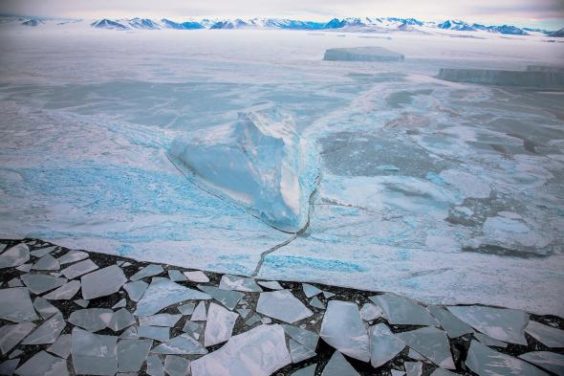 World’s Largest Marine Reserve Created Off Antarctica
World’s Largest Marine Reserve Created Off Antarctica
New 598,000 square-mile protected area is more than twice the size of Texas, and will protect everything from penguins to whales.
(National Geographic) A remote and largely pristine stretch of ocean off Antarctica received international protection on Friday, becoming the world’s largest marine reserve as a broad coalition of countries came together to protect 598,000 square miles of water.
The new marine protected area in the Ross Sea was created by a unanimous decision of the international body that oversees the waters around Antarctica—the Commission for the Conservation of Antarctic Marine Living Resources—and was announced at the commission’s annual meeting in Tasmania. The commission comprises 24 countries, including the United States, and the European Union.
South of New Zealand and deep in the Southern (or Antarctic) Ocean, the 1.9 million square-mile Ross Sea is sometimes called the “Last Ocean” because it is largely untouched by humans. Its nutrient-rich waters are the most productive in the Antarctic, leading to huge plankton and krill blooms that support vast numbers of fish, seals, penguins, and whales.
World to Lose Two-Thirds of Wild Animals by 2020?
A dramatic new report warns of ecological collapse, though critics say the conclusion is overblown and misleading.
An incendiary new report from two major conservation groups predicts dire circumstances for the world’s wild animals, warning that two-thirds of vertebrate populations could be wiped out by 2020, based on 1970 population levels.
The new report, called the Living Planet Index, was prepared by the World Wildlife Fund and the Zoological Society of London. The index found that animal populations dropped by 58 percent between 1970 and 2012, largely as a result of human activities, from poaching to habitat loss and pollution.
“Trying to take all those different data sets, from all over the world, and putting that in a blender and trying to break that down into one number is irresponsible,” says [National Geographic explorer and conservation scientist Stuart Pimm of Duke University, who was not involved with the report]. “That’s disingenuous and not helpful.”
Pimm says there is far too much variability across different regions, from the land to the sea, and too much uncertainty to predict a dire crash of all species. Further, the report “depresses people to no end, and suggests there is no hope,” he says.
He points to the recent successes in stemming the decline of lions, tigers, and other big cats across Africa and Asia, some of which has been spearheaded by National Geographic’s Big Cats Initiative, which Pimm works on. As another example, a recent study found that coral reefs are actually doing better, and are more resilient in the face of warming seas and acidification, than scientists had thought.
Although conservationists face many challenges in protecting endangered species and their habitat, the actual issues they face are more varied and subtle than a single number of index can convey, says Pimm.
Such reports may be more about trying to grab attention and raise money than sound science, he says.
Conservation biologist Luke Dollar, who leads National Geographic’s Big Cats Initiative, says he agrees with Pimm’s assessment of the Living Planet Index. “That said, there’s no question that a great number of populations of myriad species are in substantial decline, and will continue to demand ever-increasing efforts to stem their loss and protect the systems of which they are a part,” says Dollar.
World’s food and energy systems key to tackling global biodiversity decline
(WWF) Global wildlife could plunge to a 67 per cent level of decline in just the fifty-year period ending this decade as a result of human activities, according to WWF’s Living Planet Report 2016. The report shows how people are overpowering the planet for the first time in Earth’s history and highlights the changes needed in the way society is fed and fuelled.
According to the report, global populations of fish, birds, mammals, amphibians and reptiles have already declined by 58 per cent between 1970 and 2012, the most recent year with available data. This places the world on a trajectory of a potential two-thirds decline within a span of the half-century ending in 2020.
Fortunately, 2020 is also a year of great promise. In that same year, commitments made under the Paris climate deal will kick in, and the first environmental actions under the globe’s new sustainable development plan are due. If implemented, these measures, along with meeting international biodiversity targets set for 2020, can help achieve the reforms needed in the world’s food and energy systems to protect wildlife across the globe.
Living Planet Report 2016: Risk and resilience in a new era is the eleventh edition of WWF’s biennial flagship publication. The report tracks over 14,000 vertebrate populations of over 3,700 species from 1970 to 2012.
3 October
A Virtuous Cycle for Conservation
Arancha González & John E. Scanlon say that when the poor gain a stake in the wildlife trade, they become resolute defenders of nature.
(Project Syndicate) The biggest threats to the legal wildlife trade are poaching, smuggling, improper trade permitting, and animal abuse, all of which must be addressed by regulators and rural community stakeholders at the local level. Fortunately, rural communities are already in the best position to protect wildlife, so long as they are motivated to do so. In the right circumstances, a virtuous cycle, whereby local producers have a direct interest in protecting wildlife (because they are benefiting from its legal trade) is the best – and sometimes the only – long-term solution to the problem of sustainability.
To help with this, governments can increase rural communities’ resource- and wildlife-use rights so that they can manage and protect their natural resources sustainably. For example, in the 1970s when Peru granted Andean communities the right to use vicuña wool, it saved the vicuña from extinction and created new, long-term income streams for the community. Because legal and natural circumstances vary by country and community, we will need similar policy innovations across different sectors.
One promising sector is tourism, which also fits into the CITES framework. To take one example, since Rwanda began sharing wildlife-tourism revenues with local communities, the mountain-gorilla population has grown. As we see time and again, when local communities are included, they can become resolute wildlife defenders.
More generally, we should be supporting scientists working on new adaptive-management methods, and the private sector should be given incentives to invest in greater sustainable sourcing and increased supply- and production-chain transparency.
As the examples above show, conservation and improved livelihoods for the rural poor are feasible, and even mutually reinforcing. With more political will and smart investments, there is no reason we can’t reach the SDGs to both reduce poverty and safeguard wildlife for future generations.
15 September
Obama Creates Connecticut-Size Ocean Park, First in Atlantic
The first national monument in the Atlantic will protect deep canyons along the continental shelf and a chain of extinct undersea volcanoes.
(National Geographic) In a milestone for ocean protection, President Barack Obama on Thursday established the first marine national monument in the Atlantic, prohibiting commercial fishing and other types of extraction in a series of deep canyons and extinct undersea volcanoes that lie more than 150 miles off southern New England, along and beyond the continental shelf.
“The notion that the ocean I grew up with is not something I can pass on to my kids and my grandkids is unacceptable. It’s unimaginable,” Obama said in announcing the Northeast Canyons and Seamounts Marine National Monument at the State Department’s Our Ocean conference in Washington, D.C. “Dangerous changes in our climate caused mainly by human activity, dead zones in our ocean caused mainly by pollution that we create here on land, unsustainable fishing practices, unprotected marine areas in which rare species and entire ecosystems are at risk. All those things are happening now. They’ve been happening for a long time. So if we’re going to leave our children with oceans like the ones that were left to us, we’re going to have to act and we’re going to have to act boldly.”
The monument consists of two distinct areas covering a total of 4,900 square miles. The first, running in a strip along the edge of the continental shelf, will protect three massive canyons cut thousands of feet into the shelf.
7 June
The Great Barrier Reef: a catastrophe laid bare
Australia’s natural wonder is in mortal danger. Bleaching caused by climate change has killed almost a quarter of its coral this year and many scientists believe it could be too late for the rest. Using exclusive photographs and new data, a Guardian special report investigates how the reef has been devastated – and what can be done to save it
by Michael Slezak
Coral bleaches when the water it’s in is too warm for too long. The coral polyps gets stressed and spit out the algae that live in inside them. Without the colourful algae, the coral flesh becomes transparent, revealing the stark white skeleton beneath.
And because the algae provides the coral with 90% of its energy, it begins to starve. Unless the temperatures quickly return to normal, the coral dies and gets taken over by a blanket of seaweed.
Once that happens it can take a decade for the coral to recover – and even then that recovery depends on the reef not being hit by other stressors such as water pollution.
While the hard corals are still holding their structure under the seaweed blanket, the soft corals are dying; dripping off the dead coral skeletons.
The thick seaweed is a sign of extreme ecosystem meltdown. Fish can no longer use the coral structure as shelter – blocked by the plants – and before long the coral structures themselves are likely to collapse, leaving little chance of full recovery within the next 10 years.
When the coral dies, the entire ecosystem around it transforms. Fish that feed on the coral, use it as shelter, or nibble on the algae that grows among it die or move away. The bigger fish that feed on those fish disappear too. But the cascading effects don’t stop there. Birds that eat fish lose their energy source, and island plants that thrive on bird droppings can be depleted. And, of course, people who rely on reefs for food, income or shelter from waves – some half a billion people worldwide – lose their vital resource.
2015
20 April
Guelph barcoding conference highlights need for ‘library of life’
(Guelph Mercury) “It’s been 650,000 centuries since life on our planet was decimated, and we’re living in the century where it’s happening again.”
This is how Paul Hebert began as he kicked off the sixth International Barcode of Life Conference at the University of Guelph on Tuesday
Hebert is the director of the Biodiversity Institute of Ontario at the University of Guelph and the father of DNA barcoding technology. To a nearly full auditorium at Rozanski Hall, he spoke of the urgency of the barcoding project. Referencing ecologist Mark Urban in the journal Science, Hebert said one sixth of all species on our planet could be extinct by the end of this century. First proposed by Hebert, DNA barcoding is a technique that allows researchers to identify an organism using short, standardized regions of genetic material. Barcode of Life was launched in 2010, and last week, the project successfully reached the benchmark of barcoding 500,000 species.
Canadian scientist’s mission: Barcode every single species on earth
(Globe & Mail) If life on Earth is like a vast library – one book per species – Paul Hebert’s dream is to catalogue that library and reveal, for the first time, the full scope of the richness that it contains.
His nightmare is that we are burning the books without even bothering to read them.
“One third of the living species on our planet could be gone by the end of this century,” said Prof. Hebert, who heads the Biodiversity Institute of Ontario at the University of Guelph.
By “something” Prof. Hebert means a project of unprecedented scale, a biological moonshot in which Canada would play a leading role.
The time has come, he says, to genetically index every multicellular species on Earth – estimated to number somewhere between 10 and 20 million – before a large share of those species vanish without a trace.
29 May
China agrees to phase out its ivory industry to combat elephant poaching
Conservationists hail China’s first ever commitment to phase out legal, domestic manufacture and sale of ivory products as a victory in the fight to save Africa’s elephants
China has committed to phasing out the domestic manufacture and sale of ivory products for the first time. Conservation groups said the announcement was “the single greatest measure” in the fight to save the last African elephants from poaching.
At an event in Beijing where foreign diplomats witnessed 662kg of confiscated ivory being symbolically destroyed, Zhao Shucong, head of China’s State Forestry Administration, said: “We will strictly control ivory processing and trade until the commercial processing and sale of ivory and its products are eventually halted.”
This is the first time China has committed to phase out its legal, domestic ivory industry. Lo Sze Ping, CEO of WWF’s China division applauded the Chinese government’s strengthening resolve to reduce demand in the world’s biggest market for trafficked ivory.
2014
1 October
A fascinating illustration of the importance of biodiversity and the ecosystems that it creates
Wolves Introduced To Park To Revitalize Ecosystem (video narrated by George Monbiot)
In 1995, naturalists re-introduced wolves into Yellowstone National Park in 1995. These wolves were on their own initially but that soon spiraled into something much more amazing
8 April
Our Bees, Ourselves — Bees and Colony Collapse
(NYT) Honeybee collapse has much to teach us about how humans can avoid a similar fate, brought on by the increasingly severe environmental perturbations that challenge modern society.
Honeybee collapse has been particularly vexing because there is no one cause, but rather a thousand little cuts. The main elements include the compounding impact of pesticides applied to fields, as well as pesticides applied directly into hives to control mites; fungal, bacterial and viral pests and diseases; nutritional deficiencies caused by vast acreages of single-crop fields that lack diverse flowering plants; and, in the United States, commercial beekeeping itself, which disrupts colonies by moving most bees around the country multiple times each year to pollinate crops.
The real issue, though, is not the volume of problems, but the interactions among them. Here we find a core lesson from the bees that we ignore at our peril: the concept of synergy, where one plus one equals three, or four, or more.
8 April
Qualified good news for biodiversity – at least in Europe
EU study finds honey bees death rates are lower than feared
(Planet Ark) A pioneering European Union survey into the impact of pests and diseases on honey bees found death rates were lower than feared, in part countering concerns about the collapse of colonies of the crop-pollinating insects.
Last week, the Red List of the International Union for Conservation of Nature found that almost a quarter of Europe’s wild bee population is at risk of extinction because of loss of habitats and climate change.
The Commission, the EU executive, also said current indicators showed wild bees, closely related to the honey bees and also vital pollinators, were in “a worrying decline”. It has banned the use of certain pesticides, known as neonicotinoids, suspected of harming bees. They are produced mainly by Germany’s Bayer and Switzerland’s Syngenta.
In addition, EU policy-makers are trying to address bee health by insisting on measures such as crop diversification as part of reforms to the Common Agricultural Policy.
14 February
 The report “Arctic Biodiversity Assessment ” was prepared by 253 scientists from 15 countries under the auspices of the Arctic Council. The printed 674 pages report weighs an impressive 2.9 kg!…
The report “Arctic Biodiversity Assessment ” was prepared by 253 scientists from 15 countries under the auspices of the Arctic Council. The printed 674 pages report weighs an impressive 2.9 kg!…
Arctic biodiversity under serious threat from climate change according to new report
Climate change caused by human activities is by far the worst threat to biodiversity in the Arctic
(Eureka) Unique and irreplaceable Arctic wildlife and landscapes are crucially at risk due to global warming caused by human activities according to the Arctic Biodiversity Assessment (ABA), a new report prepared by 253 scientists from 15 countries under the auspices of the Conservation of Arctic Flora and Fauna (CAFF), the biodiversity working group of the Arctic Council.
“An entire bio-climatic zone, the high Arctic, may disappear. Polar bears and the other highly adapted organisms cannot move further north, so they may go extinct. We risk losing several species forever,” says Hans Meltofte of Aarhus University, chief scientist of the report.
From the iconic polar bear and elusive narwhal to the tiny Arctic flowers and lichens that paint the tundra in the summer months, the Arctic is home to a diversity of highly adapted animal, plant, fungal and microbial species. All told, there are more than 21,000 species. ABA Report and synthesis
UN agencies, others sign pact on illegal wildlife trade
Eleven United Nations agencies and 46 countries signed The London Declaration to protect wildlife. The declaration’s provisions include the criminalization of illegal wildlife trading and a focus on stopping the trade of ivory. BBC (2/13), BBC (2/13)
12 February
Freshwater atlas to help nations conserve biodiversity
(SciDev.net) An online repository of maps has been launched to make information on freshwater biodiversity available on a common platform for use by scientists, policymakers, conservationists and NGOs.
The Global Freshwater Biodiversity Atlas will help developing countries identify biodiversity-rich areas for conservation. It was launched last month (29 January), as part of an EU-funded project called BioFresh, with the aim of putting together published maps and sharing them under a creative commons licence.
Experts say it could help developing nations better manage their biodiversity and meet targets, for example by identifying the areas where conservation can be most effective.
David Strayer, researcher at the Cary Institute of Ecosystem Studies in the United States, says: “There’s a unique and very high biodiversity in the freshwaters but when we talk about biodiversity people think about coral reefs and tropical rainforests. They don’t think of freshwater as rich in biodiversity. Sites like these have the potential to increase the visibility of biodiversity in freshwaters, its threatened status and maybe solutions to protecting it.”
William Darwall, manager of the Freshwater Biodiversity Unit, IUCN in Cambridge, United Kingdom, says that some countries in Africa, for example The Democratic Republic of Congo (DRC), are keen to meet targets set out under the Convention on Biological Diversity.
“As part of that process they need to figure out where the network of protected areas should be to best represent biodiversity,” says Darwall.
9 January
Biodiversity panel gives indigenous knowledge core role
Indigenous and local knowledge is set to play a major role in biodiversity and ecosystem management, a meeting of an intergovernmental body has heard.
At its second meeting — held in Antalya in Turkey, last month (9-14 December) — the Intergovernmental Platform on Biodiversity & Ecosystem Services (IPBES) decided to extend its focused assessments of such knowledge over the full five years of its work programme.
In addition, the platform will provide funding and technical support to help integrate indigenous knowledge into the assessments.
IPBES was established in April 2012 with a mandate to assess the state of the world’s biodiversity and ecosystems, and help policymakers make well-informed decisions. A founding principle is to integrate indigenous and local knowledge into conservation processes.
2013
Special report: Biodiversity
All creatures great and small
(The Economist) BIODIVERSITY, once the preoccupation of scientists and greens, has become a mainstream concern. Liberal helpings of growth and technology are the best way of preserving it, says Emma Duncan (print edition of 14 September)
16 August
Global Fail: Dropping ‘Oil in the Soil’ Plan, Ecuador Opens Biodiversity Hotspot to Oil Drilling
President Correa: “It was not charity that we sought from the international community, but co-responsibility in the face of climate change
 A view from the Yasuní national park. (Photo: sara y tzunky/cc/flickr)
A view from the Yasuní national park. (Photo: sara y tzunky/cc/flickr)
(Common Dreams) Ecuador announced it is opening an Amazonian nature preserve to oil drilling, abandoning a conservation plan of using international funds to leave the oil in the soil.
The preserve, the Yasuní national park, has been described as the most biodiverse place on Earth and is home to several indigenous tribes, as well as some 900 million barrels of heavy crude.
“The world has failed us,” President Rafael Correa said in a televised speech on Thursday. “It was not charity that we sought from the international community, but co-responsibility in the face of climate change.”
Ecuador approves Yasuni national park oil drilling in Amazon rainforest
Environmentalists devastated as president blames lack of foreign support for collapse of pioneering conservation plan
(The Guardian) Ecuador has abandoned a pioneering conservation plan in the Amazon that attempted to raise funds from the international community instead of drilling for oil in a pristine corner of the Yasuni national park.
The collapse of the Yasuni ITT initiative is a devastating blow for activists who are trying to save one of the world’s most biodiverse regions from development and pollution. It also kills climate campaigners’ hopes that the Ecuador plan could provide a model for other nations to resist the lure of oil money and leave fossil fuels under the ground.
the termination of the conservation initiative has stirred up fury among environmentalists and is likely to upset the population at large. Polls show that between 78% and 90% of Ecuadoreans are opposed to drilling in this sensitive region.
Kelly Swing, the founder of the Tipitini research centre in Yasuni, said the area affected by drilling could be 20 or 30 times more than the government has claimed once access roads are factored in. “A new road is the death knell to any wilderness area, no matter where in the world,” he said.
Ecuador Exposes Rain Forest and its Inhabitants to Oil Extraction Effort
(PBS Newshour) Thousands of species of plant and wildlife call Ecuador’s Yasuni National Park home, but it is believed that beneath the lush floor lies $7.2 billion of oil. Drilling could threaten the rain forest’s biodiversity and indigenous populations. Some scientists argue a balance could be found.
15 August
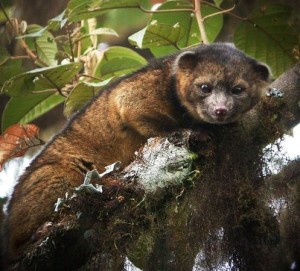 New mammal discovered in Andean cloud forest
New mammal discovered in Andean cloud forest
Olinguito is a fruit-eating relative of the raccoon living in the Andes Mountains
(CBC) A tree-dwelling animal with a teddy-bear-like face and rust-coloured fur has become the newest mammal species discovered by scientists.
The olinguito, the smallest known member of the raccoon family, lives in the cloud forests high in the Andes Mountains of Colombia and Ecuador, reported a team of scientists from the Smithsonian Institution in Washington, D.C., which described it in the journal ZooKeys Thursday.
The animal has actually been displayed in museums and zoos over the past 100 years, but was mistakenly identified as a different, known species among its close relatives, the olingo.
The olinguito isn’t new – it was with us all along. Let’s hope it stays that way — The newly named mammal may well already be on the road to extinction. And its cuteness will not offer much protection (The Guardian) New Carnivore Revealed: Photos of the Olinguito and its Kin (Natl Geographic)
5 August
How the World’s ‘Most Biodiverse Place’ Could Be Ransomed for Oil Money
(PBS NewsHour) This piece is part of a collaboration on the Yasuni National Park between the Miami Herald and the PBS NewsHour. Read more about the project here.
27 May
George Monbiot: A Manifesto for Rewilding the World
Through rewilding – the mass restoration of ecosystems – I see an opportunity to reverse the destruction of the natural world. Researching my book Feral, I came across rewilding programmes in several parts of Europe, including some (such as Trees for Life in Scotland and the Wales Wild Land Foundation) in the UK, which are beginning to show how swiftly nature responds when we stop trying to control it (18,19). Rewilding, in my view, should involve reintroducing missing animals and plants, taking down the fences, blocking the drainage ditches, culling a few particularly invasive exotic species but otherwise standing back. It’s about abandoning the Biblical doctrine of dominion which has governed our relationship with the natural world.
22 May – International Biodiversity Day
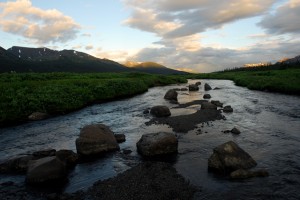
The boreal, with all its fish and insects, supports more than 300 species of birds, the report says. And it has healthy populations of grizzly bears, timber wolves and wolverines, which have disappeared from most of their historic North American range.
Photograph by: Handout , Postmedia News
Boreal forest as ‘special’ as Amazon
Diversity hot-spot worthy of global attention and protection, report says
From caribou herds to landlocked seals, Canada’s boreal forest is rich in biodiversity treasures and just as worthy of global attention and protection as the Amazon, according to two leading conservation groups.
A report to be released Wednesday by the Boreal Songbird Initiative and Ducks Unlimited lists 10 top biodiversity hot spots in Canada’s boreal forest, which encompass large swaths of the landscape.
21 May
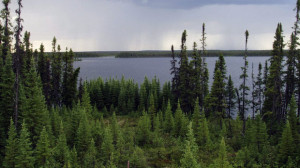 Forestry companies argued that the size of land that conservationists wanted protected in the deal would have shut down several mills and projects in Ontario and Quebec, part of whose boreal forest is seen in the photo above. (Matt Medler/International Boreal Conservation Campaign/Associated Press)
Forestry companies argued that the size of land that conservationists wanted protected in the deal would have shut down several mills and projects in Ontario and Quebec, part of whose boreal forest is seen in the photo above. (Matt Medler/International Boreal Conservation Campaign/Associated Press)
Deal to protect boreal forest caribou fails
Resolute Forest Products, conservationists break off 3-year negotiations over size of protected area
Three years of negotiations between Resolute Forest Products and environmental groups aimed at protecting Canada’s boreal forest have ended in failure, with talks breaking down over how much land to set aside for conservation.
Resolute said Tuesday it could not accept a proposal from environmentalists that it says would have threatened thousands of jobs in remote communities.
“The final asks of the environmental organizations that were brought to us last evening were so extreme, were so draconian they would have forced the closure of multiple mills, multiple projects throughout Quebec and Ontario,”
3 May
Global biodiversity panel urged to heed local voices
(SciDev.net) A newly established global panel on biodiversity faces being sidetracked by niche interests and northern agendas if it does not tread carefully, a meeting has heard.
The Intergovernmental Platform on Biodiversity & Ecosystem Services (IPBES) was formed in April 2012, with a mandate to assess the state of the planet’s biodiversity and ecosystems, and provide accessible scientific advice to policymakers.
But it faces several challenges. The key issue to emerge at an IPBES stakeholders’ meeting in Paris, France, this week (29–30 April) was how to involve voices from the global South, including those of indigenous communities, traditional and local knowledge holders, women, and civil society organisations.
29 January
Global biodiversity panel holds first plenary meeting
(SciDev.net) The Intergovernmental Platform on Biodiversity and Ecosystem Services (IPBES) held its first plenary meeting last week (21–26 January), during which the science panel that will advise on the latest relevant research and data was appointed.
IPBES was established in April 2012 as an independent, intergovernmental body, modelled on the Intergovernmental Panel on Climate Change (IPCC), to assess the state of the planet’s biodiversity and ecosystems. Its members convened in Bonn, Germany, at a meeting billed as IPBES’s first plenary.
2012
George Monbiot: Biodiversity offsets threaten both the survival and the meaning of nature.
Propose a get-out clause and – however many warnings and caveats you wrap round it – before long it will be used. This post is about the dangerous new concept the government has seeded in the minds of developers and planners.
The idea is called biodiversity offsetting. It involves trading places: allowing people to destroy wildlife and habitats if, in return, they pay someone to create new habitats elsewhere. In April the UK government launched six pilot projects to test the idea, which would run for two years.
Four months ago, I wrote this:
“The government warns that these offsets should be used only to compensate for ‘genuinely unavoidable damage’ and ‘must not become a licence to destroy’; but once the principle is established and the market is functioning, for how long do you reckon that line will hold?”
The answer, it seems, is “not very long”. A year and a half before the pilot projects have been completed, the new spirit of destruction is roaming the land. A place of outstanding wildlife value is now being considered for demolition, and biodiversity offsetting is being mooted as the means by which it can be justified. It’s hard to believe that this scheme would still be receiving serious consideration if the mother of all excuses had not been proposed by the government.
13 November
UNEP Pays Tribute to Angela Cropper
(UNEP News Center) Angela Cropper, the former Deputy Executive Director of the United Nations Environment Programme (UNEP) has passed away following a long and courageous battle with cancer.
Ms Cropper, who more recently had been serving as UNEP’s Special Advisor for the Rio+20 Summit, died at her home in London on 12 November.
A national of Trinidad and Tobago, Ms. Cropper began her career as an economist.
She later held senior positions with the Caribbean Community and Common Market Secretariat (CARICOM) and the World Conservation Union (IUCN), followed by positions as interim Executive Secretary of the UN Convention on Biological Diversity and as Senior Adviser on Environment and Development with the United Nations Development Programme.
She also served as an independent member of the Senate of the Parliament of Trinidad and Tobago.
Ms. Cropper oversaw and played a key role in many landmark studies and assessments, including the Millennium Ecosystem Assessment (2005). She led two sub-global assessments on the Northern Range in Trinidad and the Caribbean Sea.
A testament to her vision and achievements, Ms. Cropper received several environmental awards for her advocacy work in equity, peace and sustainable development, at both international and local levels.
Rich, poor nations step up to save biodiversity
Rich nations have agreed to double aid to developing nations, to about $10 billion, to preserve biodiversity. The deal comes after two weeks of negotiations at a United Nations conference in Hyderabad, India. Developing nations, too, pledged to increase spending to protect endangered species. ScienceMag.org/ScienceInsider blog (10/22), Deutsche Welle (Germany) (10/22), Forbes/Green Tech blog (10/22)
6 October
The Biodiversity Bargain
(Project Syndicate) What will it cost to save the world’s forests and boost the life prospects of its seven billion people? In a few days, India will host a meeting in Hyderabad of the United Nations Convention on Biological Diversity. The assembled countries will consider how to raise the resources necessary to achieve the ambitious Aichi Biodiversity Targets, adopted two years ago at the last such meeting in Japan.
 The Aichi targets call for cutting by half the rate of loss of the planet’s natural habitats, including forests, by 2020. In Hyderabad, governments will be presented with the likely costs of scaling up efforts to achieve that goal.
The Aichi targets call for cutting by half the rate of loss of the planet’s natural habitats, including forests, by 2020. In Hyderabad, governments will be presented with the likely costs of scaling up efforts to achieve that goal.
One assessment estimates that about $40 billion a year will be needed to halve rates of deforestation and ensure sustainable management of forests in developing countries by the target date. The cost may seem significant in a world of rising unemployment rates, with many countries still struggling with ongoing financial and economic crises, and others staring bankruptcy in the face.
But the cost of preserving the world’s biodiversity needs to be contrasted with the enormous economic and social value of forests in terms of the benefits that they provide locally and globally. Forests ensure water supplies, counter soil erosion, and safeguard an abundance of genetic resources that will become increasingly important in developing the new products, pharmaceuticals, and crop strains needed to support the lives and livelihoods of more than nine billion people by 2050. Moreover, investing in forest conservation and sustainable land use is one of the most cost-effective means of mitigating climate change.
24 August
Tropical biodiversity reserves faltering
![]() A study reports that conservation efforts in some of the world’s most biologically diverse areas are having positive results. However, many reserves — so-called “arks” of biodiversity — were struggling under the stresses of human activity across the tropical regions of Africa, the Americas and Asia Pacific. EnvironmentalResearchWeb.org (U.K.) (8/24)
A study reports that conservation efforts in some of the world’s most biologically diverse areas are having positive results. However, many reserves — so-called “arks” of biodiversity — were struggling under the stresses of human activity across the tropical regions of Africa, the Americas and Asia Pacific. EnvironmentalResearchWeb.org (U.K.) (8/24)
7 July
Biodiversity Without Borders
(IPS) The protection and conservation of biodiversity figure among the most daunting challenges posed by climate change in the Caribbean islands, home to a wealth of endemic species of flora and fauna.
The Caribbean Biological Corridor (CBC), an initiative spearheaded by the Dominican Republic, Cuba and Haiti, with the support of international cooperation agencies, offers an opportunity for joint projects that will benefit biodiversity not only within their own borders, but in the Caribbean region as a whole.
Jamaica, Puerto Rico, Guadeloupe and Martinique have expressed interest in participating in the process as observers and guests, and could eventually join in as full partners in the biological corridor, which serves as a sort of umbrella initiative for “practical action” projects.
The initiative provides a framework of cooperation for protecting natural resources and stemming the loss of biodiversity in the Caribbean region through environmental remediation and development of alternative livelihoods.
15 June
This would be laughable were it not published in a paper that some people read
ROTHBARD AND DRIESSEN: U.N.’s threat to biodiversity
‘Green’ agenda is not healthy for children and other living things
(Washington Times) Rio+20 seeks to shift international focus to “biodiversity” and supposed threats to plant and animal species as the new “greatest threat” facing planet Earth. This rebranding is “by design,” according to conference organizers, who have been uncharacteristically candid in describing sustainable development and biodiversity as an “easier sell” than climate change. It’s a simpler path to advance the same radical goals.
Saving biodiversity by providing for people
Conservation International is helping to preserve biodiversity by helping communities understand the economic importance of conservation, says Chairman and founder Peter Seligmann. “[W]henever we deal with issues that are pressing social needs — water, energy food, jobs, health — environment is always the piece that you discount,” Seligmann said. “But when you do that, you sabotage the sustainability of a society.” The New York Times (tiered subscription model)/Green blog (5/25)
7 March 2012
UN biodiversity chief eyes private investment
(AlertNet/Reuters) It would cost some $300 billion a year over the next eight years to preserve the global biodiversity in animal and plant life, said Braulio Ferreira de Souza Dias, the new chief of the UN Convention on Biological Diversity. The figure — meeting which would require public-private partnerships — is about 10 times the amount now spent on the sustainable management of agriculture, forests, and fresh water, coastal and marine ecosystems.
15 February
Braulio Ferreira de Souza Dias assumes helm at Secretariat of the Convention on Biological Diversity
(CBD Communiqué) … Mr. Dias, a Brazilian national, brings many years of experience in policy-making and in coordinating the implementation of biodiversity policies, programmes and projects at the national and international level. Deeply involved with the negotiations and implementation of the Convention on Biological Diversity since its beginnings, he participated as a member of the Brazilian delegation in the Intergovernmental Negotiating Committee for the Convention.
Mr. Dias succeeds Ahmed Djoghlaf, who had served as Executive Secretary since January 2006.
2011
9 November
Is it time to give up on tigers and pandas?
(The Independent) Controversial plans to save one species at expense of another are gathering pace
A majority of professional conservationists believe it is time to consider shifting efforts away from some of the world’s most famous species, such as the panda, to concentrate on others which have a greater chance of success.
20 September
Key UN protocol on biodiversity receives another 13 signatories
(UN News Center) Thirteen countries today signed a key protocol to a United Nations treaty promoting a more equitable sharing of the planet’s genetic resources and their benefits as the annual UN event aimed at encouraging States to sign, ratify or accede to various global pacts and accords kicked off.
The protocol envisages the setting up of an international regime on access and benefit sharing of genetic resources, which will lay down the basic ground rules on how nations cooperate in obtaining genetic resources, according to the administrative offices of the 193-member Convention on Biological Diversity (CBD), which drafted the protocol.
It outlines how benefits – for example, from when a plant’s genetics are turned into a commercial product, such as medicine – will be shared with countries and communities which conserved and managed that resource, in some cases for millennia.
July 1, 2011
The Secretariat of the CBD expands in Montréal
The Secretariat of the Convention on Biological Diversity (SCBD) expanded its offices in the Montréal World Trade Centre. Located in the Québec metropolis since 1996, this United Nations organization is expanding to prepare for the implementation of the Nagoya Protocol. Adopted by 193 states in October 2010 in Nagoya, Japan, the Protocol on Access to Genetic Resources and the Fair and Equitable Sharing of Benefits Arising from their Utilization has since been signed by 30 countries.
The inauguration ceremony, which was attended by several foreign delegations participating in the first meeting of the Open-ended Ad Hoc Intergovernmental Committee for the Nagoya Protocol, was also an opportunity to celebrate the United Nations Decade on Biodiversity. Québec’s Minister of International Relations, Ms. Monique Gagnon-Tremblay, attended the event. Montreal International
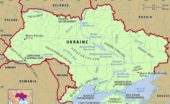

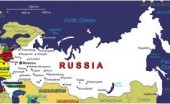

One Comment on "The UN Decade on Biodiversity 2011-2018"
Here you can find information about biodiversity, events around the world, and how we can make a difference. Take part!